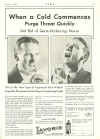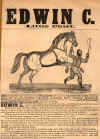

|
Advertising Analysis: Notes and Questions |
||
|
|
First Considerations
1. The underlying argument of any ad is, of course: "Buy this product." Many times, though, the argument is not made primarily through logos but through pathos and ethos. They persuade not so much through a logical text (literal meaning) but through an emotional subtext -- an unstated underlying meaning. Older advertisements tended to be bigger on logos than many contemporary ones are. The Lavoris ad below relies primarily on step-by-step description of the process of how Lavoris purges your throat. Why is there all this description of process in a logical ad? How does including it help sell the product? What is the logical argument that the ad for the horse, Edwin C, is trying to make?
2. The argument/ad is undoubtedly affected by what audience it is trying to persuade. Who is that audience? How can you tell? What does the text imply about readers' knowledge or feelings about the product? Why, according to the author, should the audience be interested in this product?
3. What are the things the ad assumes you value? (Clue: in many of them, you'll be assumed to value a quality that old people call "cool" or "grooviness." Under these circumstances, the question becomes: How is this quality defined by the ad? How does the Kool ad below define coolness?
3a. What does the ad assume you know already about the product? Note this ad for the game "Risk," which assumes that the audience is familiar with the game's basic point:
If the ad assumes that you know a lot about the product, you should make sure to think about Question 14 below -- what ethos/character does the ad try to assign to the product?
4. Back to the overall argument of the ad: What, specifically, does the writer want the audience to do, think, feel, or decide after reading the ad?
5. What does the ad ask (or enable) a reader to do while she is reading: compare facts, apply information, pick up the phone and call her state senator, implement some other action, etc.? How does this help sell the product?
Given what you've figured out about the author's overall argument and audience, the one essential question you will ask is: Why does the ad make this particular choice? Why does the writer think this will help sell the product?
Logos (with what techniques does the writer present the argument as reasonable and logical?)
6. Does the ad make any particular logical claims for the superiority of the product? (In the Edwin C example above, the ad argues that the superiority of Edwin C's ancestry makes him an exceptional horse.)
7. What, if anything, is the evidence given for this claim? Does the writer give quotes (from whom)? Does she use statistics, description? Does she use examples, stories? Why do you think she chose these particular pieces of evidence to help sell the product?
8. What is/are the warrant(s) underlying this claim? For instance, if an ad says "You should buy Rixtrol because it contains more Chemahex than any other product." (One of the warrants for this argument is: "Chemahex is something you need badly." The next question becomes: Does this warrant get any backing? That is, does the ad support in any way the statement that you need Chemahex?)
9. Are there any flaws in the ad's logic that you can detect? More likely than gaping holes in logic are errors regarding relevance -- that is, including evidence that simply doesn't belong, or evidence that the writer doesn't connect thoroughly enough to her point. Are there any cases of this?
10. Where does the writer use a lot of detail, and where does she stay relatively general? Why?
11. Does the writer anticipate readers' objections or questions? Does it seem like she is putting forward something that she anticipates a lot of resistance to?
Ethos (with what techniques does the product gain credibility or a feeling of trust?)
12. How would you characterize the writer's tone of "voice"? Friendly? Serious? Threatening? Does she use "our," "we," "us," and "you"? Who's included in the "we" and the "they" (note that these pronouns to not need to be explicitly supplied for the writer to divide the world into us and them)? How do these choices help the author?
13. Does the ad rent ethos from people who already have it? How do the ads below rent the ethoi of Ray Lewis and President Harding, Princess Yedigarova, and Mrs. Fritz Kriesler?
14. Does the ad try to establish an image for the product, an ethos or character for the product as a whole? (Some companies have tried to maintain a consistent ethos through generations of customers.) Why do you think Marlboro finds this particular ethos useful in selling its product?
Pathos (with what techniques does the writer engage the audience's emotions?)
15. Who is/are the main character(s) in the ad? What kind of reaction does the ad want you to have toward this person? (Clue: two of the most commonly-asked-for reactions in advertisements are: "I'd like to be with that person" or "I'd like to be that person.")
16. Does the writer use any emotionally charged language, slanted language, or language with strong connotations -- that is, language that evokes strong emotional associations in the reader's mind? Why?
17. How do you react emotionally to the text? What are the particular features of the text that provoke these emotions?
18. What sensory experiences does the ad try to evoke?
19. What are the emotional connotations of the colors in the ad?
20. Besides people, what other objects are pictured? Why? Remember, as Hugh Rank says, "Visuals imply. They not not state explicit, rational messages. They imply or suggest emotional feelings and attitudes. Ads will not explicitly promise happiness, success, or popularity, but will show such scenes and let the visuals imply."
21. What overall mood is the ad trying to evoke? How can you tell? How do the images in the ad appeal to our emotions? Examples: Images of starving children or mistreated animals appeal to our sense of pity; images of military valor appeal to our patriotism; images of violence or extraordinary ugliness may be intended to shock us.
22. Does the ad tell a story, or refer to a familiar story? How are we expected to "buy into" the story -- that is, accept it as typical of the way things really are or of the way things should be -- as a way of "buying into" (and then buying) the product?
23. What is the overall effect of the ad's design? Colorful and busy (suggesting energy and activity)? Quiet and understated (ex. chiefly white, black, and gray, with lots of empty space)? Old-fashioned or cutting edge?
24. What about the image(s) immediately gets your attention? Size? Color? Position on the page? Beauty of the image? Ugliness/grotesqueness of the image? Humor?
25. What is the relation of text to image? Does the image do most of the work of persuasion, or does it just serve to attract us and lead us to the written text?